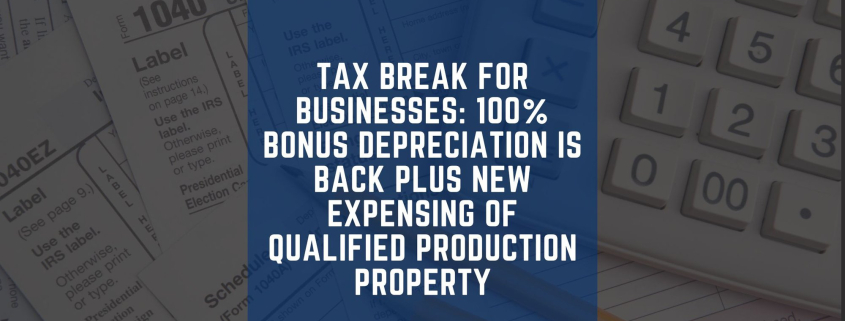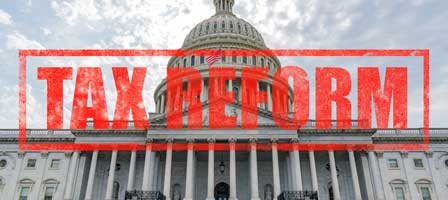Tax Break for Businesses: 100% Bonus Depreciation is Back
Article Highlights:
- Historical Context
- Tax Benefits of Bonus Depreciation
- Qualification Criteria for Bonus Depreciation
- Qualified Improvement and Property Issues
- Revoking Bonus Depreciation and AMT Implications
- Business Automobiles and Other Depreciation Rules
- Issues Addressed by the Recent Reinstatement
- Qualified Production Property
Recent U.S. tax legislation reinstates bonus depreciation as a critical component to foster economic growth. The 2017 Tax Cuts and Jobs Act (TCJA) had already put significant emphasis on bonus depreciation. The permanent reinstatement under the "One Big Beautiful Bill Act" at 100% further emphasizes its importance, especially after considering the economic ramifications of the pandemic. This article explores the tax benefits, historical context, applicability, and specific rules surrounding bonus depreciation, ultimately outlining the recent changes in its reinstatement.

Historical Context: Originally Enacted to Stimulate the Economy
Bonus depreciation was first introduced as part of the Job Creation and Worker Assistance Act in 2002. It allowed businesses to immediately deduct a substantial amount of the cost of qualifying property, rather than having to recover the cost as depreciation over a number of years. Lawmakers initially set the deduction at 30%, then increased it to 50%, and eventually to 100% during specific economic downturns.
The TCJA significantly altered bonus depreciation by allowing a 100% first-year deduction for qualified property, which was a substantial incentive for businesses. Lawmakers designed this provision to encourage capital procurement and economic growth. However, the TCJA also included a sunset provision that began phasing out the bonus depreciation rate starting in 2023, and by 2027 no bonus depreciation would have been allowed.
Tax Benefits of Bonus Depreciation
Bonus depreciation allows businesses to fully deduct the cost of assets in the year they place them into service, providing immediate tax relief and encouraging investment. This benefit enhances a company's cash flow by reducing taxable income, making it a powerful incentive for purchasing new assets.
However, utilizing bonus depreciation effectively requires careful planning. For example, the Section 199A deduction is based on qualified business income (QBI), and writing off large capital purchases can reduce an entity’s profit, consequently decreasing the Sec 199A deduction. Conversely, reducing taxable income might help avoid certain phase-outs and limitations associated with 199A.
Qualification Criteria for Bonus Depreciation
Qualifying property includes tangible items with a recovery period of 20 years or less. This also includes computer software, water utility property, and qualified improvements and productions. The IRS sets the recovery periods. Most business vehicles have a recovery period of 5 years. Most office equipment has a 7-year recovery period. Bonus depreciation does not generally apply to real property. Generally, real property has a recovery period of 27.5 or 39 years, depending on its use. Single-purpose agricultural structures, such as a silo or greenhouse, are 10-year property, and a retail motor fuel outlet (more than 50% of sales are petroleum related, 50% or more of its floor space is devoted to petroleum, and the building is 1400 feet or less) is 15-year property and would qualify for bonus depreciation.
The TCJA expanded eligible property to include both new and used qualifying assets. This change encourages investment in second-hand equipment. The law excludes public utility properties from bonus depreciation. It also excludes dealer vehicle properties, which adds complexity.
Qualified Improvement and Property Issues
Qualified improvement property initially experienced legislative challenges. The intent under the TCJA was to combine properties such as leasehold, restaurant, and retail improvements into a category eligible for bonus depreciation under a 15-year MACRS recovery period. However, an oversight initially excluded these properties, later corrected by the CARES Act.
Revoking Bonus Depreciation and AMT Implications
Bonus depreciation applies unless a taxpayer elects out of bonus depreciation on a timely filed return, or on an amended return filed within six months of the original due date for the timely filed return that did not opt out of bonus depreciation. A benefit of bonus depreciation is that property for which it has been taken is not subject to AMT adjustments.
Business Automobiles and Other Depreciation Rules
Special rules apply to business automobiles considered “luxury autos.” In years when bonus depreciation applies, the depreciation limit increases by $8,000. Lawmakers established this rule under the TCJA. Since OBBBA does not mention the increase, most expect it to continue. Related party rules add further complexity. Section 179 rules also apply and require pre-bonus depreciation adjustments. Section 179 lets businesses deduct property purchases instead of depreciating them. However, the taxpayer must recapture the amount claimed in excess of the applicable straight-line depreciationdeduction if business use drops below 50% in a later year.
Issues Addressed by the Recent Legislation
The OBBBA reinstatement extends the 100% deduction for qualified property purchased and placed in service after January 19, 2025. OBBBA has made bonus depreciation permanent. For qualifying property placed in service between January 1, 2025, and January 19, 2025, the bonus depreciation remains at 40%.
This continuity provides businesses with long-term planning capabilities and aligns investments with broader economic policies intended to spur growth.
Qualified Production Property
The "One Big Beautiful Bill Act" also introduced a provision to promote manufacturing in the U.S. Before OBBBA, taxpayers generally deducted the cost of business-related nonresidential real property over a 39-year period. The law also limited bonus depreciation to tangible personal property, excluding real estate.
Effective for property placed in service after July 4, 2025, OBBBA generally, allows taxpayers to immediately deduct 100% of the cost of certain new factories, certain improvements to existing factories, and certain other structures. Specifically, this provision allows taxpayers to deduct 100% of the adjusted basis of qualified production property in the year such property is placed in service.
Qualified Production Property refers to specific portions of nonresidential real property that meet a set of criteria:
- The property must be used by the taxpayer as an integral part of a qualified production activity.
- It must be placed in service within the United States or any possession of the United States.
- The original use of the property must commence with the taxpayer.
- Construction of the property must begin after January 19, 2025, and before January 1, 2029.
- The property must be designated by the taxpayer in an election on the taxpayer’s tax return. The IRS will issue instructions on how to make this election.
- The property must be placed in service before January 1, 2031.
- Any portion of a property that is used for offices, administrative services, lodging, parking, sales activities, research activities, software engineering activities, or certain other functions is ineligible for this benefit
Production Machinery
Even though manufacturing machinery that does not qualify as qualified production property is not expensed under this provision, it will generally qualify for Section 179 expensing or 100% bonus depreciation that is reinstated by OBBBA.
Qualified Production Activity: Generally, a "Qualified Production Activity" is defined as follows:
- Activities Involved: It refers to the manufacturing, production (limited to agricultural and chemical production), or refining of a qualified product. These activities should result in a substantial transformation of the property comprising the product.
- Qualified Product: A qualified product refers to any tangible personal property that is not a food or beverage prepared in the same building as a retail establishment in which such property is sold.
In summary, for an activity to qualify under this section, it must involve significant production or transformation processes, excluding certain types of agricultural and chemical productions.
Recapture rules apply in certain cases when the taxpayer changes the use of qualified production property within 10 years of placing it in service. If the taxpayer sells the property, they must report any gain—up to the amount of bonus depreciation claimed—as ordinary income rather than capital gain.
The reinstatement of bonus depreciation is a vital tool for economic rejuvenation, providing businesses with immediate tax incentives to make capital investments.
While it offers substantial benefits, understanding the complexities and planning strategically around QBI deductions, AMT implications, and specific qualifications is essential. Amid legislative nuances and phased-out provisions, bonus depreciation remains a keystone in strategic business planning for enduring economic development. The addition of the qualified production property provides a huge incentive for building production facilities in the U.S. While thought of as a deduction for big business, it can also apply to small manufacturing facilities.
If you are in business and have questions about how the Bonus Depreciation can benefit your business, contact our professionals at www.Fiducial.com/consultations.









